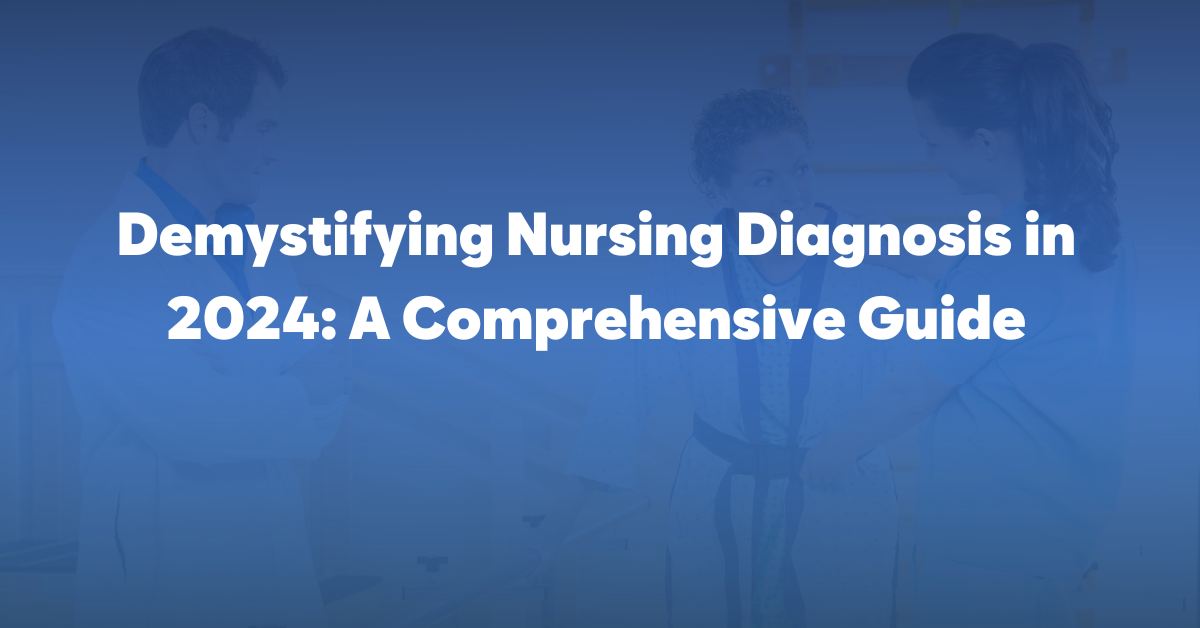Nurses serve as the backbone of patient care. The role of a nurse extends beyond administering medications and performing procedures. They are integral in assessing, diagnosing, and planning the care of patients. One essential aspect of nursing practice is nursing diagnosis, a crucial step in the nursing process that guides the delivery of patient-centered care.
As we step into 2024, let us delve into the intricacies of nursing diagnosis and understand its significance in contemporary healthcare.
Understanding Nursing Diagnosis
Nursing diagnosis is a clinical judgment concerning a patient’s response to actual or potential health problems or life processes. Unlike medical diagnoses, which focus on diseases or pathologies, nursing diagnoses revolve around the patient’s holistic response to illness, injury, or life events. These diagnoses provide the foundation for planning individualized nursing interventions to promote health and facilitate healing.
Over the years, nursing diagnosis has undergone significant evolution. From its inception by the North American Nursing Diagnosis Association (NANDA) in the 1970s to its current state in 2024, nursing diagnosis frameworks have become more comprehensive and evidence-based. Today, nurses utilize standardized taxonomies such as NANDA International, Nursing Interventions Classification (NIC), and Nursing Outcomes Classification (NOC) to ensure consistency and effectiveness in the diagnostic process.
Components of Nursing Diagnosis
Diagnostic Label: This describes the patient’s health problem or response, derived from standardized nursing terminologies. It encapsulates the essence of the patient’s condition, guiding subsequent interventions. For example, “Impaired Gas Exchange” or “Ineffective Coping.”
Related Factors: Also known as etiology, related factors are the underlying causes or contributing factors that predispose the patient to the identified health problem. Understanding these factors enables nurses to address the root cause of the issue. For instance, “Impaired Gas Exchange related to pneumonia as evidenced by shortness of breath and low oxygen saturation.”
Defining Characteristics: These are the signs and symptoms that support the presence of the nursing diagnosis. Nurses gather data through assessment to identify these defining characteristics, which further validate the diagnosis. For example, “Ineffective Coping as evidenced by decreased social interactions, altered sleep patterns, and expressions of hopelessness.”
Importance of Nursing Diagnosis
Individualized Care: By tailoring interventions to specific nursing diagnoses, nurses address each patient’s unique needs, preferences, and responses. This personalized approach enhances the effectiveness and efficiency of care delivery.
Outcome-Oriented Care: Nursing diagnoses guide the selection of appropriate interventions and facilitate the evaluation of patient outcomes. Nurses can measure the effectiveness of interventions by assessing improvements in the patient’s condition relative to the identified diagnosis.
Interdisciplinary Communication: Nursing diagnoses provide a common language for communication among healthcare providers, fostering collaboration and continuity of care. They facilitate the exchange of information regarding the patient’s health status, goals, and progress across various healthcare settings.
Evidence-Based Practice: By utilizing standardized taxonomies and evidence-based guidelines, nurses ensure the accuracy and reliability of nursing diagnoses. This evidence-based approach enhances the quality and safety of patient care, promoting optimal outcomes.
Practice and Implementation
Integrating nursing diagnosis into clinical practice requires a systematic approach:
Assessment: Nurses conduct comprehensive assessments to gather data on the patient’s health status, including physical, psychological, social, and spiritual dimensions. This data forms the basis for identifying nursing diagnoses.
Analysis: Nurses analyze assessment data to identify patterns, trends, and deviations from normalcy. They prioritize the most pressing health issues and formulate nursing diagnoses based on their clinical judgment and evidence-based guidelines.
Planning: Once nursing diagnoses are established, nurses collaborate with patients, families, and interdisciplinary teams to develop individualized care plans. These plans outline goals, interventions, and expected outcomes related to each nursing diagnosis.
Implementation: Nurses implement the planned interventions, utilizing their clinical expertise and evidence-based practices to address the identified nursing diagnoses. They monitor the patient’s response to interventions and adjust as necessary.
Evaluation: Nurses evaluate the effectiveness of interventions by assessing changes in the patient’s condition and progress towards achieving goals. They revise care plans as needed and communicate findings to the healthcare team and stakeholders.
Conclusion
In conclusion, nursing diagnosis remains a fundamental aspect of nursing practice in 2024, guiding the delivery of patient-centered care in an increasingly complex healthcare environment. By understanding the components, importance, and implementation of nursing diagnosis, nurses can optimize outcomes and enhance the quality of care for their patients. As we continue to advance in the field of healthcare, nursing diagnosis remains a beacon of excellence, ensuring that every patient receives the attention, support, and interventions they deserve.





